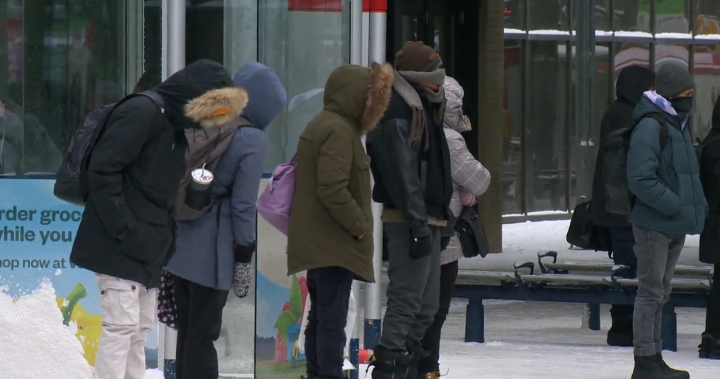With an extreme cold warning come some extreme cold injuries.
And doctors in emergency departments worry about two basic kinds of injuries coming through their doors: frostbite-damaged skin and hypothermia.
“Starting with the frostbite, this is essentially a cold-induced burn of skin and the tissue underneath. And in these temperatures it can happen in a matter of minutes,” Dr. Eddy Lang, emergency medicine department head at the University of Calgary’s Cumming School of Medicine, said.
A polar vortex is pulling Arctic air into Western Canada and the United States. An extreme cold warning across all of Alberta and Saskatchewan, and parts of British Columbia and Manitoba, warns of wind chill values of between -40 and -50, with low temperatures well below -30 C.
At those temperatures, skin can freeze within minutes.
“Often the frostbite creates pain and discomfort initially, but then a numbing feeling, making it sometimes not possible to realize that people are in trouble,” Lang said.
”The people who unfortunately are most at risk for this are those who don’t have stable housing and don’t have a warm place to stay.”
Lang said time is of the essence when treating people suffering from frostbite, and new treatments can reverse the effects of frostbite, preventing amputation.
Hypothermia can be life-threatening and fatal, he said.
“This will occur sometimes in combination with bad judgement,” Lang said. “People who are consuming alcohol or other substances and are out and about in this terribly cold weather might fall, hit their head, fall asleep on a snowbank, and without realizing it, their body temperatures fall to dangerously low levels as a result of being exposed in these conditions for simply a matter of 15 or 20 minutes.”
Adam Loria, public education officer with Alberta Health Services EMS, said crews have been responding to hypothermia and frostbite calls since the polar vortex brought unseasonably cold temperatures to the province.
Get the latest National news.
Sent to your email, every day.
He said calls related to slips and falls on icy surfaces are also seen during these conditions, and advised having the proper footwear and clothing.
“We’re really advocating that if you’re going to be outside in these elements, whether you work outside, make a living, you’re commuting to and from work or to public transit, or you just want to get some exercise, please do it safely,” Loria said.
“Dress in layers. It’s easier to take a layer off and reapply it at a later time should you become warm versus being outside, becoming cool and not having enough layers.”
Lang advises people not to venture outside in the Arctic temperatures, but if you do have to venture outdoors, he recommends wearing warm layers and covering as much skin as possible.
“Frostbite also occurs at the tip of the nose, and if you don’t have a good scarf on and you’re taking a long walk in these cold conditions, you can get quite serious frostbite to the tip of the nose as well,” Lang said.
Frost nip is a telltale sign of oncoming frostbite.
“Your skin will become kind of blanched and doughy and yellowish for a little while. It’ll be uncomfortable and as it heats up, you can actually see quite marked redness,” the emergency department doctor said, saying most of the time that doesn’t require an emergency department visit.
“You may actually see blistering and dark skin and bluish skin with a little bit of bleeding actually occurring under the skin.
“If you’re seeing any of those things, you do need medical attention and you should have your skin, or whatever area you think may have been frostbitten, evaluated in an emergency department (which) will be able to tell you right away.”
Lethargy and confusion are the telltale signs of hypothermia.
“If someone’s not making sense and they’ve been outdoors in the cold for that long, you probably need to call 911 or get them to an emergency department so that they can have their body temperature checked, which is not always the easiest thing to do,” Lang said. “When you’re freezing cold, we have special thermometers in the emergency department that can verify someone’s temperature.”
Loria said anyone is susceptible to hypothermia and frostbite if they aren’t prepared for the temperatures.
“Look out after each other. If you are out commuting, working, getting exercise, fresh air, ideally go in groups just to look after each other for signs and symptoms of hypothermia and or frostbite,” the AHS EMS spokesperson said.
© 2024 Global News, a division of Corus Entertainment Inc.




